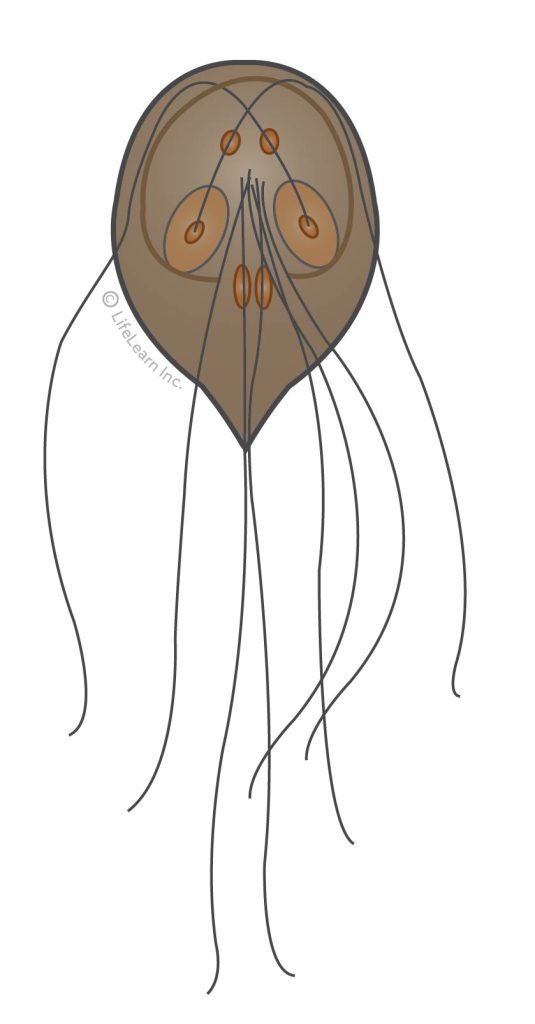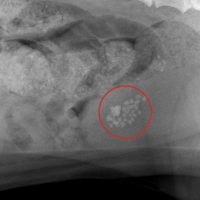What is Giardia?

Giardiasis is an intestinal infection in humans and animals caused by a microscopic protozoan. It is a simple one-celled parasitic species, not a worm, bacteria, or virus. The parasite occurs worldwide and is a common cause of “Traveler’s Diarrhea” in people. Outdoor enthusiasts who inadvertently consume contaminated water may develop “beaver fever,” another name for giardiasis in people. Other examples of protozoan parasites that can cause enteric (intestinal) disease are coccidia, cryptosporidia, and toxoplasma.
Giardiasis can be a significant cause of illness, especially diarrhea, in animals and people. However, most dogs infected with Giardia do not have diarrhea, vomiting, or any other signs of illness.
The Giardia organism has two forms. A fragile feeding form, known as the trophozoite, exists in the gut of infected animals. A hardy cystic form is shed in feces and can survive several months in the environment, particularly in water and damp environments.
How do dogs get giardiasis?
A dog becomes infected with Giardia when it swallows the cyst stage of the parasite. In susceptible dogs, once the cyst passes into the dog’s intestines, it transforms into the trophozoite and attaches to the intestinal wall to feed. If sufficient numbers are present, clinical signs of damage to the intestinal wall will develop.
Trophozoites reproduce by dividing, and some transform into the cystic form. Eventually, the dog passes infectious cysts in its stool. The time it takes from ingestion of cysts to passage in feces is 5 to 12 days in dogs and 5 to 16 days in cats.
These cysts are immediately able to infect another animal. Giardiasis can be transmitted by eating or sniffing the cysts from contaminated ground or drinking contaminated water.
When Giardia cysts are found in the stool of a healthy adult dog without diarrhea, they are generally considered a transient, insignificant finding. However, in puppies and debilitated adult dogs, they may cause severe, watery diarrhea that may be fatal if left untreated.
The likelihood of developing disease increases when large numbers of cysts are present in the environment from fecal contamination. Giardiasis is common in densely populated environments, such as kennels, pet stores, or animal shelters.
What are the clinical signs of giardiasis?
These microscopic parasites attach themselves to the intestinal wall, and the damage causes an acute, sudden onset of foul-smelling diarrhea. Giardia infection in dogs may lead to weight loss, chronic intermittent diarrhea, and fatty stool. The stool may range from soft to watery, often has a greenish tinge, and occasionally contains blood. Infected dogs tend to have excess mucus in their feces. Vomiting may occur in some cases. The signs may persist for several weeks, and gradual weight loss may become apparent.
Diarrhea may be intermittent. Most dogs do not have a fever but may be less active. The disease is not usually life-threatening unless the dog’s immune system is immature or immunocompromised. Many dogs will be asymptomatic carriers, never developing any signs of illness. Younger animals are more likely to exhibit clinical signs.
How is giardiasis diagnosed?
A routine fecal flotation test may fail to detect these tiny cysts, which are shed inconsistently in the feces and often require a special zinc sulfate flotation solution. Occasionally, the parasites may be seen on a direct smear of the feces. If your veterinarian suspects giardiasis, a stool sample may be analyzed for Giardia–specific antigens (cell proteins). Some Giardia tests are available for in-clinic use, while others require submission to a reference laboratory. Many cases are presumptively diagnosed based on medical history and clinical signs suggestive of giardiasis.
How is giardiasis treated?
The most common drugs used to kill Giardia are fenbendazole (Panacur®) and metronidazole. These drugs are usually given for three to ten days to treat giardiasis. Both drugs may be given in combination if necessary. This combination is usually administered to dogs with refractory diarrhea (diarrhea that hasn’t responded to treatment). Supportive treatment with other drugs may be needed as supplemental therapy if dehydration or severe diarrhea is present.
A low-residue, highly digestible diet may help lessen loose stools during treatment. Some dogs may require follow-up tests and treatments based on their condition and severity of infection. All infected pets should be re-tested two to four weeks after completion of treatment. Your veterinarian will help determine the treatment best for your pet.
Because Giardia cysts are infective immediately when passed into the environment, feces should be removed quickly and disposed of. Infected animals should be bathed regularly to remove cysts from the hair coat.
What is the prognosis for giardiasis?
The prognosis is good in most cases. Debilitated or geriatric animals and those with incompetent immune systems are at increased risk for complications, including death. All pets diagnosed with Giardia should be re-tested two to four weeks after completion of treatment.
Can my dog give a Giardia infection to me or my family?
Giardia can cause diarrhea in humans and can be passed from dogs to humans. In the past, it was assumed that cats, dogs, and wildlife were an important source of human infection. Genotype A can infect humans, dogs, and cats, while B can infect both humans and dogs.
However, human-to-human transmission is also important, and contaminated municipal water supplies are responsible for many outbreaks.
If your dog is diagnosed with giardiasis, environmental disinfection and good personal hygiene are essential to prevent accidental spread to humans. In particular, people with immunodeficiency, such as AIDS, cancer, or undergoing chemotherapy, should use extreme care, especially when handling feces or after administering medications.
For environmental disinfection, you can use chlorine bleach at 1:32 or 1:16 dilutions or 1-2 cups in a gallon of water (60-120 ml/L). However, be sure that the affected surfaces can be safely treated with bleach. Lysol® and quaternary ammonium compounds (e.g. Parvosol®) are also reported to kill cysts effectively. Giardia cysts are susceptible to drying, so keep your environment as dry as possible. For best results, thoroughly clean the pet’s living and sleeping areas and then allow the areas to dry out for several days before reintroducing pets.
© Copyright 2022 LifeLearn Inc. Used and/or modified with permission under license.






